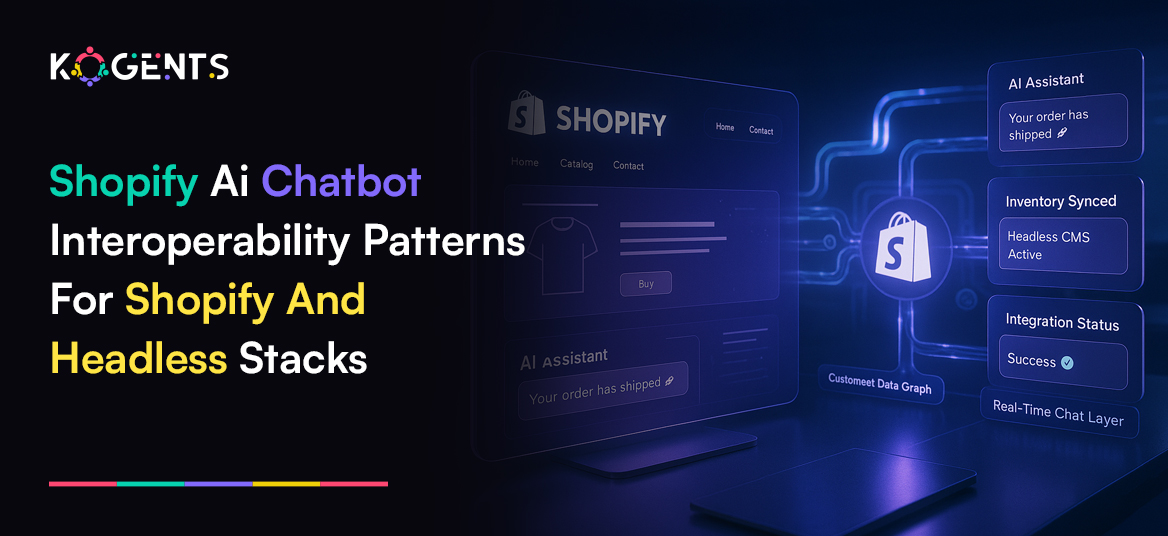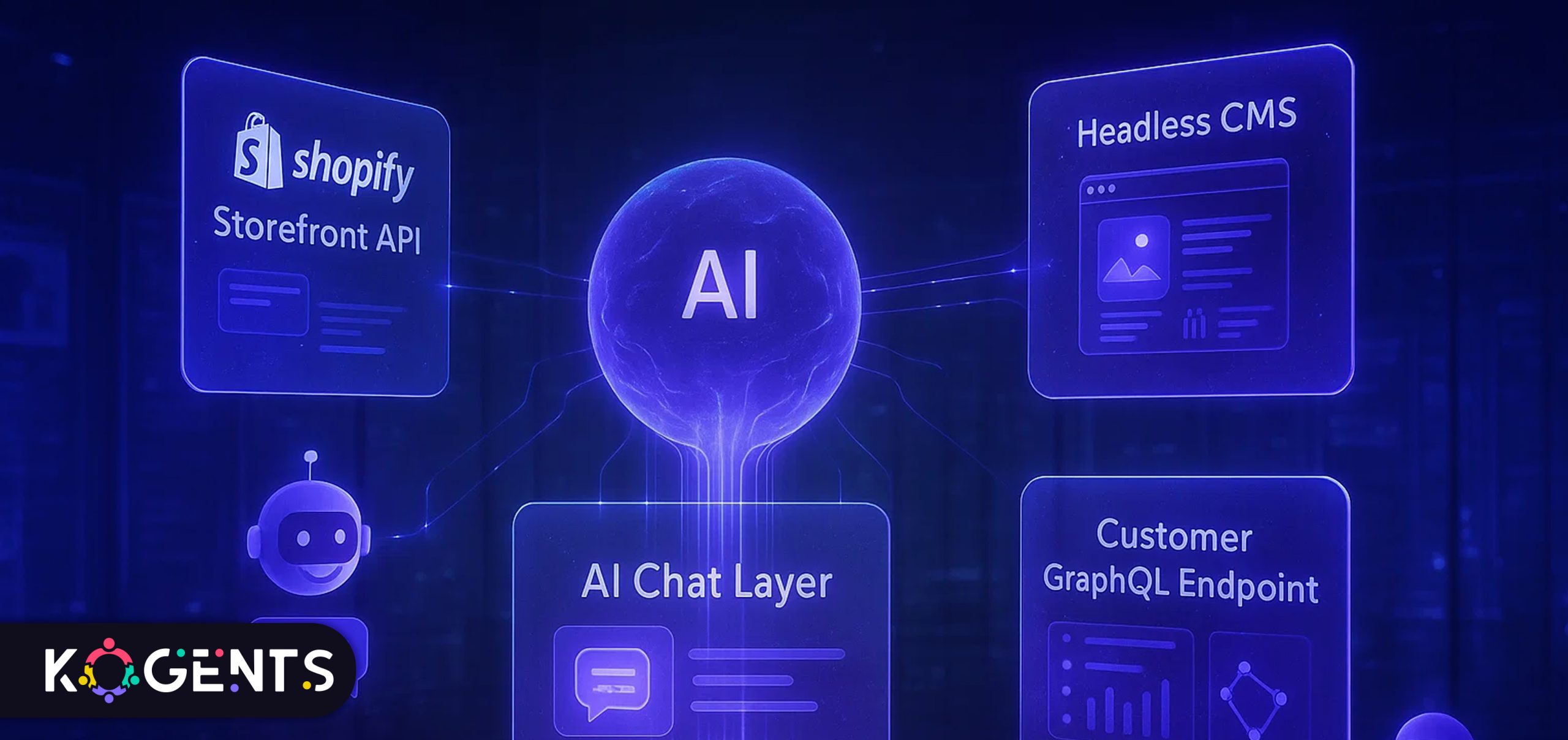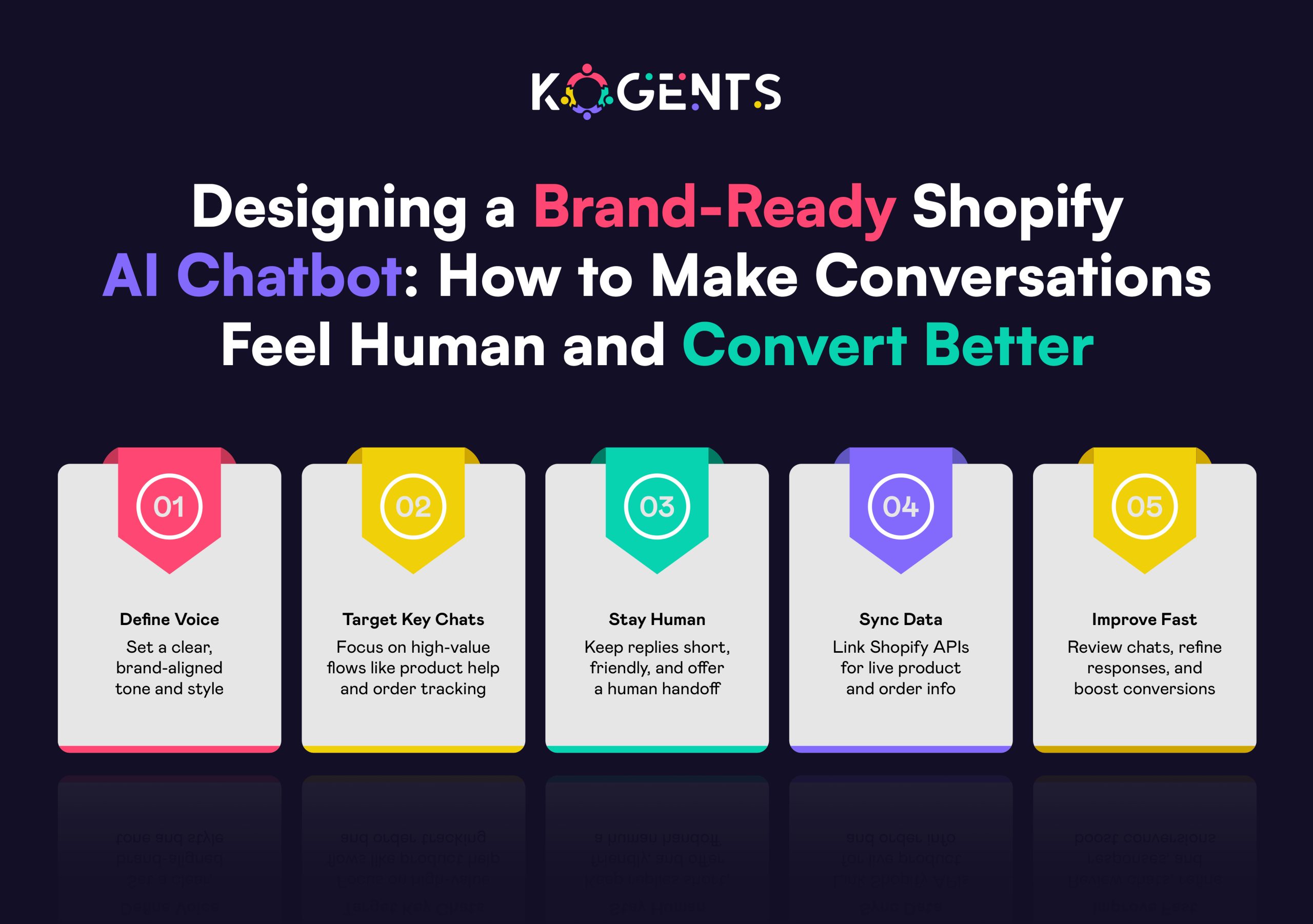Shopify AI Chatbot Interoperability Patterns for Shopify and Headless Stacks

Summary:
In the high-stakes world of online retail, entrepreneurs and solopreneurs in the world are constantly seeking ways to scale smarter, not harder.
Just step up in the era of Shopify Inbox and other “Shopify AI chatbot” solutions that blend conversational AI, machine learning (ML), and natural language processing (NLP) to deliver real-time support, drive conversions, and automate repetitive workflows.
But for merchants using a traditional Shopify setup or advancing into a more flexible headless stack, the question becomes: how do you architect interoperability in a way that preserves data integrity, supports omnichannel flows, and maintains the agility that solopreneurs need?
This post dives deep into Shopify AI chatbot interoperability patterns for Shopify and headless stacks, customized for e-commerce entrepreneurs and solo founders.
Key Takeaways
- True interoperability for a Shopify AI chatbot means connecting to live store data, knowledge bases, and support systems, not just a simple chat widget.
- When moving toward a headless stack, the architecture expands: you’ll need robust API layers, event-driven messaging, and a single source of truth across front-end and backend systems.
- For merchants, localization, compliance (based on region and compliance laws), and trust signals are critical when deploying AI chatbots for customer support and sales automation.
- The commercial value of a best Shopify AI chatbot includes improved conversion rates, reduced support ticket volume, stronger brand voice, and round-the-clock availability.
- Solopreneurs must balance simplicity and sophistication: a turnkey Shopify-app approach may suffice early on, but as ambitions grow (headless, omnichannel), you’ll need more architecture and governance discipline.

Know and Comprehend Interoperability Patterns
Interoperability for a Shopify AI chatbot refers to how the chatbot integrates and works across multiple systems (storefront, backend, headless layers, live-chat, CRM, knowledge-base) coherently.
It’s more than just “installing a chat widget”. It means real-time data flow, context awareness, hand-off mechanisms, and scalable architecture.
Why does it matter for e-commerce and headless stacks?
- Customer expectations are high: instant answers, personalized service, 24/7 availability. A rudimentary chatbot that cannot check order status or know cart details falls short.
- When using a headless stack (separating front-end presentation from backend data), interoperability becomes more complex. You might have a custom front-end (React, Next.js, Nuxt, etc.), plus APIs for products, orders, and inventory. The chatbot must span those layers.
- E-commerce automation and AI-driven Shopify virtual assistant capabilities thrive when the bot can trigger workflows (e.g., cart abandonment recovery, product recommendations, upsells) and feed into analytics and flow builders.
- For solopreneurs or small teams, building the right pattern early means you avoid technical debt, reduce support loads, and create higher-impact automation.
Primary Interoperability Patterns
Here are several patterns you’ll find when deploying a Shopify AI chatbot in various stacks:
- Embedded Shopify App Pattern
- The chatbot is installed as an app from the Shopify App Store and runs within the standard Shopify theme/cart experience.
- Pros: Quick to set up, minimal developer work, good for solopreneurs.
- Cons: Less flexible for headless, may be limited in custom workflows.
- API-Driven Integration Pattern
- The chatbot connects to Shopify’s Admin/API endpoints (orders, AI-driven customer experience, products) to retrieve real-time information.
- Pros: Good for both Shopify and headless stacks, supports personalized responses, and dynamic data.
- Cons: Requires API knowledge, security & access management.
- Use case: Mid-sized merchants, solopreneurs who are comfortable with more advanced integration.
- Headless / Decoupled Stack Pattern
- The storefront is decoupled (React/Vue/Gatsby, etc.), and the chatbot lives as a service that integrates across your headless frontend API, plus Shopify backend, plus possibly other systems (CRM, helpdesk).
- Pros: Maximum flexibility, omnichannel support, full control.
- Cons: More complex, needs architecture governance, and development resources.
- Use case: Proven brands or entrepreneurs scaling rapidly, U.S. market presence across web, mobile app, and even voice.
- Omnichannel Unified Bot Pattern
- The chatbot sits at the centre of multiple channels: web chat widget, mobile app, messaging platforms (WhatsApp, Facebook Messenger), voice assistants, all linked back to Shopify or your backend.
- Pros: Future-proof, broad audience reach, consistent experience.
- Cons: High complexity, requires a strong data flow architecture.
- Knowledge-Base / AI-Assist Hybrid Pattern
- The chatbot not only interacts with the storefront but also integrates the knowledge base, FAQs, and helpdesk system to escalate when needed. See, for example, detailed how-to guides.
- Pros: Improves support deflection, personalization, and automates handovers.
- Cons: Requires knowledge-based governance, alignment between bot and human agents.
Interoperability Patterns at a Glance
| Pattern Name | Ideal For | Complexity | Key Technologies | Considerations |
| Embedded Shopify App | Solopreneurs, simple stores | Low | Shopify App, chat widget | Fast install, limited customization |
| API-Driven Integration | Growing stores on Shopify | Medium | Shopify Admin API, Webhooks | Must secure data/API keys, comply with CCPA |
| Headless / Decoupled Stack | Scaling brands with a custom front-end | High | Headless CMS, GraphQL/REST API, chatbot service | More dev cost, higher flexibility |
| Omnichannel Unified Bot | Multi-channel U.S. brands | Very high | Messaging APIs, chat widget, voice assistant | More channels = more rules + governance |
| Knowledge-Base / AI-Assist Hybrid | Support-intensive stores | Medium/High | Knowledge base software, hand-off logic | Ensures consistent brand voice, reduces tickets |

Architecture Blueprint for “Shopify AI Chatbot + Headless Stack”
Let’s outline a high-level architecture blueprint.
- Front-end Layer
- Choice: Classic Shopify theme or headless front-end (React/Next.js, Vue/Nuxt) using Shopify Storefront API.
- Chat widget is embedded or served as a micro-frontend.
- Chatbot Engine / Conversational Layer
- Conversational AI service (in-house or SaaS) leveraging NLP/ML, able to handle intents like “track my order”, “what size is available”, “recommend alternatives”, “I want to return”.
- Integration with the knowledge base and fallback to a human agent.
- Backend / Commerce Platform
- Shopify Admin API (orders, customers, products), Webhooks for events (order placed, cart abandoned), and Inventory API.
- If headless, may have separate microservices for products, customers, and a datastore.
- Integration & Orchestration Layer
- API gateway or middleware to standardize calls between front-end, chatbot engine, Shopify, support systems, and CRM.
- Event-driven architecture: for example, when a cart abandonment event is triggered → chat proactively engages the user.
- Data syncing: customer profile, conversation history, chat transcripts stored for analytics and personalization.
- Knowledge Base / Support Layer
- FAQs, help articles, product instructions, policy pages, and chatbot searches this to answer complex queries.
- Live-chat handoff: if the user screams “speak to a human”, the bot transfers context and data to a human agent.
- Analytics & Monitoring
- KPIs: chat resolution rate, conversion rate uplift, support ticket volume reduction, and average response time.
- Compliance logs, user consent records (especially important for U.S. consumer protection).
- Model monitoring (if using ML) for drift.
- Compliance & Privacy Layer
- Store consent, anonymize personal data as needed. Consider data protection (CCPA) and ensure the third-party SaaS used for chatbot is compliant.
- Accessibility (WCAG) for chat widget.
Interoperability Patterns in Action: Case Studies
Case Study 1: Small U.S. boutique – Embedded Shopify App
A solo founder in California sells handcrafted gifts via a standard Shopify store.
She installed a no-code chatbot app labelled “AI chatbot Shopify US market” from the Shopify App Store.
The bot integrated with her product catalog and could answer product questions and alert shoppers about limited editions.
With minimal setup (less than 2 hours), she activated the chat widget, set simple triggers (cart > $75 => free shipping chat), and saw a 15 % lift in conversion in the first month.
Case Study 2: U.S. mid-sized brand – API-Driven Integration
A U.S. apparel brand with circa USD 500k annual revenue decided to deploy an AI chatbot for post-purchase support (order tracking, returns) and pre-sale recommendations.
They used a framework described by Kore.ai: create a custom Shopify app, generate API credentials, connect the chatbot engine to Shopify scopes (read_orders, read_products, read_customers), and install prebuilt templates.
The bot reduced support tickets by 30 % and improved customer satisfaction (CSAT) by 20 %. They built the bot in-house but used a SaaS engine for NLP.
Deployment Roadmap for Solopreneurs & Entrepreneurs
Solopreneur Roadmap
- Select a ready-made Shopify App labelled “AI chatbot for Shopify”, install from the Shopify App Store.
- Configure basic flows:
- Order status lookup (22 % of chats often ask this).
- FAQ automation (returns, shipping time).
- Cart abandonment prompt (e.g., “see something in your cart? Can I help you decide?”).
- Product recommendation micro-flow (e.g., “looking for something under $50?”)
- Embed chat widget on your Shopify theme (header or bottom-right).
- Track metrics: Chat start, chat to checkout conversion, support ticket deflection.
- Iterate weekly: Review chat transcripts, refine FAQs, adjust greetings, test new flows.
Entrepreneur Roadmap
- Define target use-cases: e.g., pre-sales product discovery, 24/7 post-purchase support, cart recovery, multilingual U.S. support.
- Choose architecture: API-Driven or Headless/Omnichannel, depending on your growth goals.
- Data mapping & integration:
- Connect chatbot to Shopify Admin API (customers, orders, products).
- Connect to the knowledge-base system (helpdesk).
- Connect to CRM or tagging system for lead capture and follow-up.
- Define governance: Version control for chatbot flows, escalation rules, compliance review, and analytics dashboard definitions.
- Pilot phase: Launch with limited flows (order lookup, FAQs) in the U.S. region, monitor performance, and refine.
- Scale phase: Add proactive flows (cart abandonment, product recommendations, multilingual support), embed across channels (web, mobile app, Messenger), and monitor ROI.
- Continuous improvement: Use ML/NLP to classify new intents appearing, train the bot accordingly, monitor the fallback rate, track conversion uplift, and support cost savings.
Example: According to Shopify, “businesses that reply quickly with Inbox see conversion rates jump by as much as 69%.”
Conclusion
The era of the Shopify AI chatbot is no longer optional; it is rapidly becoming expected.
Whether you’re a solopreneur launching your first Shopify store or an entrepreneur architecting a headless stack with omnichannel ambitions, the key is interoperability: how your bot connects across data, front-end, backend, live-chat, and support workflows.
Choose the pattern that fits your current scale (Embedded App, API-Driven, Headless, Omnichannel), then build in the architecture and governance needed to grow.
By leveraging conversational AI, natural language processing, and machine learning, your AI chatbot doesn’t just answer questions; it becomes a growth engine: automating support, guiding shoppers, and driving sales.
At Kogents.ai, we help. E-commerce solopreneurs and small teams design scalable chatbot strategies, choose the right architecture for Shopify + headless stacks, and implement ROI-driven automation.
If you’re ready to move from “installing a chat widget” to “deploying an intelligent 24/7 AI-driven sales assistant”, let’s connect!
FAQs
How does a Shopify AI chatbot work for e-commerce?
It works by connecting to your Shopify store (via APIs or the Shopify App), retrieving real-time data (orders, inventory, customers), understanding user intents via NLP, responding to queries in natural language, potentially handing off to live agents, and executing actions such as sending discount codes or updating the order. Integration with knowledge base and support systems enhances it.
What are the benefits of using an AI chatbot in Shopify for merchants?
Benefits include 24/7 chat support (reducing after-hours support burden), higher conversion rates, lower support costs, improved customer satisfaction, reduced cart abandonment (via proactive chat), and access to new channels (messaging apps, voice commerce) in the U.S. market.
How to set up an AI chatbot on a Shopify U.S. store?
Steps: choose a chatbot solution (Shopify App or custom integration); install or connect it to your store; define intents and responses; integrate with your product, order, and customer data; embed chat widget on site; test scenarios (product search, order status, returns); monitor performance; iterate. For headless stacks, include the API layer and event integration.
What technologies power Shopify AI chatbots (NLP, ML)?
Technologies include: NLP engines that parse user language, ML models that classify intents and suggest responses, chatbot platforms (no-code or custom), API connectors (Shopify Admin API, Webhooks), integration with knowledge base and support systems, and analytics platforms to monitor performance and refine the model.
What is the cost / pricing & features of a Shopify AI chatbot integration?
Pricing varies widely: basic chatbot apps may start free or low monthly fee, but may charge per chat or per resolution. Enterprises might pay more for headless integrations and omnichannel capabilities. Evaluate based on volume, features, and tax/commerce demands.
What about legal/privacy considerations for a Shopify AI chatbot in e-commerce?
Yes, merchants must consider data privacy. Under the CCPA, customers may request data deletion, opt out of the sale of personal data, and expect disclosures. If your store engages minors, consider the Children’s Online Privacy Protection Act (COPPA). Chatbot vendors should support privacy features, ensure data retention policy, and secure data (SOC 2/ISO). Always provide user consent and transparent practices.

Kogents AI builds intelligent agents for healthcare, education, and enterprises, delivering secure, scalable solutions that streamline workflows and boost efficiency.